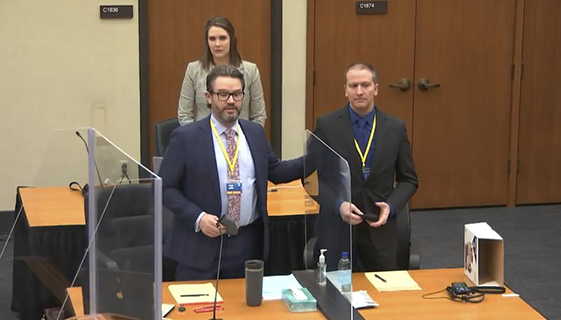By STEVE KARNOWSKI and AMY FORLITI
MINNEAPOLIS (AP) — A former Minneapolis police officer went on trial Monday in the death of George Floyd, which sparked outrage across the U.S. and beyond after bystander video showed Derek Chauvin press his knee on Floyd’s neck for about nine minutes as the Black man went limp.
The judge began by instructing the jury about its duties and about courtroom procedures ahead of opening statements.
A jury of 14 people will hear the case — eight who are white and six who are Black or multiracial, according to the court. Two of the 14 will be alternates. The judge has not said which ones will be alternates and which ones will deliberate the case.
Legal experts said they expected prosecutors to play the video to the jury early on.
“If you’re a prosecutor you want to start off strong. You want to frame the argument — and nothing frames the argument in this case as much as that video,” said Jeffrey Cramer, a former federal prosecutor and managing director of Berkeley Research Group in Chicago.
Floyd, 46, was declared dead after Chauvin, who is white, pressed his knee against Floyd’s neck for about nine minutes. He held his position even as Floyd’s “I can’t breathe” cries faded and he went limp as he was handcuffed and lying on his stomach on the pavement. Chauvin, 45, is charged with unintentional second-degree murder, third-degree murder and manslaughter.
Almost all of the jurors selected during more than two weeks of questioning said they had seen at least parts of the video, and several acknowledged it gave them at least a somewhat negative view of Chauvin. But they said they could set that aside.
Outside the courthouse Monday ahead of opening statements, Floyd family attorney Ben Crump said the trial would be a test of “whether America is going to live up to the Declaration of Independence.” And he blasted the idea that it would be a tough test for jurors.
“For all those people that continue to say that this is such a difficult trial, that this is a hard trial, we refute that,” he said. “We know that if George Floyd was a white American citizen, and he suffered this painful, tortuous death with a police officer’s knee on his neck, nobody, nobody, would be saying this is a hard case.”
The trial is expected to last about four weeks at the courthouse in downtown Minneapolis, which has been fortified with concrete barriers, fencing, and barbed and razor wire. City and state leaders are determined to prevent a repeat of damaging riots that followed Floyd’s death, and National Guard troops have already been mobilized.
The key questions at trial will be whether Chauvin caused Floyd’s death and whether his actions were reasonable.
For the unintentional second-degree murder charge, prosecutors have to prove Chauvin’s conduct was a “substantial causal factor” in Floyd’s death, and that Chauvin was committing felony assault at the time. For third-degree murder, they must prove that Chauvin’s actions caused Floyd’s death, and were reckless and without regard for human life. The manslaughter charge requires proof that Chauvin caused Floyd’s death through negligence that created an unreasonable risk.
Unintentional second-degree murder is punishable by up to 40 years in prison in Minnesota, with up to 25 years for third-degree murder, but sentencing guidelines suggest that Chauvin would face 12 1/2 years in prison if convicted on either charge. Manslaughter has a maximum 10-year sentence.
Chauvin’s attorney, Eric Nelson, was expected to use his opening statement tell jurors that medical testimony and use of force experts will show a different view. Nelson has made clear that the defense will make an issue of Floyd swallowing drugs before his arrest, seeking to convince the jury that he was at least partially responsible for his death.
The county medical examiner’s autopsy noted fentanyl and methamphetamine in Floyd’s system, but listed his cause of death as “cardiopulmonary arrest, complicating law enforcement subdual, restraint, and neck compression.”
“This case to us is a slam dunk, because we know the video is the proof, it’s all you need,” Floyd’s brother Philonise said Monday on NBC’s “Today” show. “The guy was kneeling on my brother’s neck … a guy who was sworn in to protect. He killed my brother in broad daylight. That was a modern-day lynching.”
___
Find AP’s full coverage of the death of George Floyd at: https://apnews.com/hub/death-of-george-floyd




